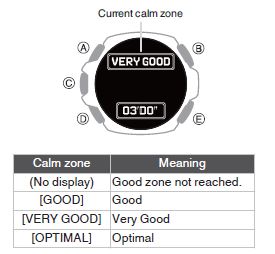
BREATHIG EXERCISE
Breathing Exercise helps you relax your body and mind and manage stress. Breathing Exercise guides you to breathe at a slow, regular rhythm – six breaths per minute, which is the optimal breathing rate for stress-relieving effects. When you breathe deeply and slowly, your heart beat starts to synchronize with the rhythm of your breathing and your heart’s beat-to-beat intervals start to vary more.
During the breathing exercise your watch helps you maintain a regular slow breathing rhythm with an animation on the watch display. Breathing Exercise measures your body’s response to the exercise and gives you real-time biofeedback on how you're doing. After the exercise, you get a summary of the time you spent in the three zones. The higher the zone, the better the synchronization with the optimal rhythm was. The more time you spend in the higher zones, the more benefits you can expect to feel in the long-term.
How to benefit from the Serene breathing exercise
When you use the Serene breathing exercise regularly, it can:
- help you manage stress
- improve the quality of your sleep
- give you a sense of improved overall well-being
How the breathing exercise works
The breathing exercise guides you to breathe deeply and slowly to calm down the body and mind. When you breathe slowly, your heart beat starts to synchronize with the rhythm of your breathing. Your heart's beat-to-beat intervals vary more when your breathing is deeper and slower. Deep breathing produces measurable responses in the heart’s beat-to-beat intervals. When you breath in, intervals between consecutive heart beats shorten (heart rate speeds up) and when you breath out, intervals between consecutive heart beats lengthen (heart rate slows down). The variance of your heart's beat-to-beat intervals is greatest when you are closest to the 6 breathing cycles per minute rhythm (inhale + exhale = 10 seconds). This is the optimal rate for stress-relieving effects. This is why your success is measured not only from the synchronization, but also from how close you were to the optimal breathing rate.
- Wear your watch snugly just behind the wrist bone.
- Sit or lie down comfortably. Check that your position allows you to keep your arms relaxed and your hands still throughout the entire breathing exercise.
- Start the breathing session and follow the breathing guidance on the display.
- The main guiding element in the animation changes current calm zone according to which three zone you're currently in.
- After the exercise, you'll see your results displayed on your watch as time spent in the different zones.
The zones are GOOD, VERY GOOD and OPTIMAL. Each zones tell you how well your heartbeat and breathing are in sync and how close you are to the optimal breathing rate of six breaths per minute. The higher the zone, the better the synchronization to the optimal rhythm. For the highest serenity zone, Diamond, you need to be able to sustain the slow target rhythm of around six breaths per minute, or slower. The more time you spend in the higher zones, the more benefits you can expect to feel in the long term.

When should I use Serene breathing exercise?
You can use the Serene breathing exercise whenever you want, here are couple of examples:
- In the morning: to minimize muscle tension and start the day with a serene mindset
- After work and during breaks: to unwind thoughts and to relax
- In the evening: to help you to fall asleep and to improve the quality of your sleep
- Before power naps: to evoke state of profound rest
- Before competition/event: to help controlling arousal level and to improve focus
Scientific background
The Breathing Exercise utilizes slow diaphragmatic breathing which is a scientifically proven method to elicit the relaxation response in the body. The body’s response is characterized by measurable changes in the heart’s beat-to-beat intervals. Slow and deep breathing drives heartbeat to follow the breathing rhythm. During inhale the beat-to-beat intervals shorten and during exhale they lengthen. In other words, heart rate speeds up with inhale and slows down with exhale. In the scientific literature, this well-known phenomenon is called respiratory sinus arrhythmia.
A breathing rate of 6 breaths/min results in the best synchronization between the heart’s beat-to-beat intervals and breathing, as well as the greatest variation in beat-to-beat intervals. In many research areas, this rhythm has been recognized to be the optimal rate for stress-relieving effects and other benefits of deep breathing. The Serene breathing exercise looks at how exact the synchronization is and how close the actual breathing rate is to the optimal one. A Polar proprietary algorithm allows quick analysis of the beat-to-beat data and provides real-time biofeedback on the success.
To achieve the full benefits of deep breathing it is recommended to practice the Breathing Exercise regularly. Many people perform the breathing exercise at about the same time every day, which may help to establish a new routine. Initially, 5 to 10 minutes per day is a reasonable goal. When done daily, scientific evidence suggests that exercise sessions lasting for about 15 to 20 minutes can yield more and longer-lasting benefits than shorter sessions. Deep breathing has been linked to many benefits such as improvements in mood, resilience to stress, emotional regulation, sleep and cardiovascular health, just to mention a few. However, it is good to keep in mind that any time spent breathing deeply is better for the mind and body than none.
Source: Polar Research
Polar science
